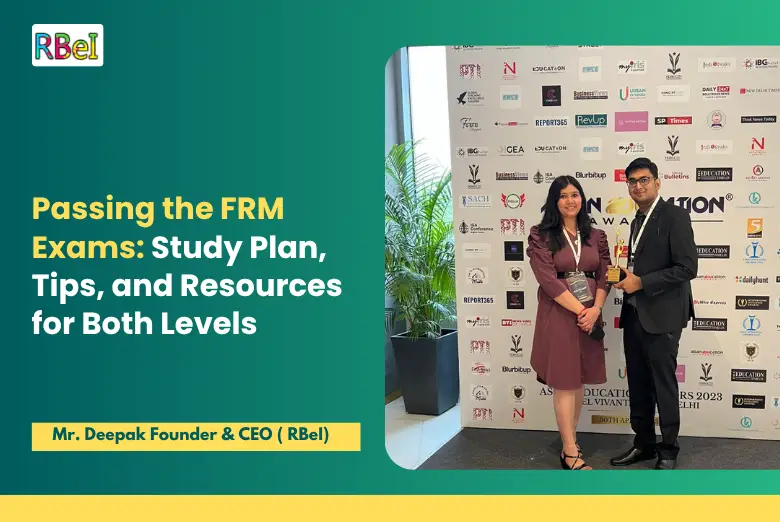Preparing for the FRM exam can be a challenging journey, but with the right FRM preparation strategy, candidates can confidently clear both Part 1 and Part 2. In this blog, we will discuss a detailed roadmap for FRM preparation that not only helps you understand the exam structure but also enables you to achieve success efficiently. Many aspirants often struggle with time management, understanding complex financial concepts, and choosing the right study resources. However, by adopting an effective FRM preparation strategy, these obstacles can be minimized, allowing you to clear both parts with confidence. This strategy will cover study schedules, resource selection, practice approaches, and mental preparation tips that ensure a comprehensive and structured approach.
Table of Contents
ToggleUnderstanding the FRM Exam: Foundation for Your Preparation Strategy
Before diving into a detailed FRM preparation strategy, it is crucial to understand the structure of the FRM exam. The FRM (Financial Risk Manager) exam is conducted by GARP (Global Association of Risk Professionals) and consists of two parts:
- FRM Part 1 focuses on the fundamental tools used in risk management, including quantitative analysis, foundations of risk management, financial markets and products, and valuation and risk models.
- FRM Part 2 builds on these concepts and emphasizes market risk, credit risk, operational risk, investment management, and risk management in financial institutions.
Understanding this distinction is vital for creating a tailored FRM preparation strategy. While Part 1 requires strong analytical skills and conceptual clarity, Part 2 demands the application of knowledge to practical risk management scenarios. Hence, your preparation strategy must adapt accordingly to these differences.
Creating a Study Plan: The Core of FRM Preparation Strategy
A well-structured study plan is the backbone of any successful FRM preparation strategy. It ensures that you allocate sufficient time for each topic while balancing practice, revision, and mock exams. Here’s how you can design an effective study plan:
1. Set Clear Goals
Begin your FRM preparation by setting realistic and achievable goals. Define your target completion timeline for Part 1 and Part 2. For instance, if you aim to clear FRM Part 1 in three months, break your preparation into weekly modules covering different topics.
2. Allocate Time Wisely
Efficient time management is critical. Divide your daily study hours between understanding concepts and practicing questions. For example, spend 60% of your time learning concepts and 40% on solving practice problems. This approach ensures a strong conceptual foundation while enhancing problem-solving skills.
3. Use a Topic-Wise Approach
A topic-wise approach ensures that no area is left uncovered. Start with fundamental topics such as quantitative analysis and risk management basics, and gradually move to complex topics like market and credit risk. Following a structured approach is a key element of a robust FRM preparation strategy.
4. Build Flexibility into Your Plan
Unexpected events may disrupt your schedule, so make your study plan flexible. Include buffer periods to revise challenging topics or take additional mock tests. Flexibility ensures consistency and reduces stress.
Choosing the Right Study Material: A Pillar of FRM Preparation Strategy
The choice of study resources significantly impacts your FRM preparation. Using outdated or incomplete materials can waste precious time. Here are some tips:

Deepak Goyal CFA & FRM
Founder & CEO of RBei Classes
- 16,000+ Students Trained in CFA, FRM, Investment Banking & Financial Modelling
- 95% Students Successfully Placed • 94.6% Pass Rate In Exam
1. Select GARP-Recommended Books
GARP provides official study materials for both parts. These books are the most reliable source for the latest syllabus, exam patterns, and question formats. Relying on GARP materials ensures that your FRM preparation strategy is aligned with exam requirements.
2. Supplement with Reference Books
While GARP books are essential, supplementing them with reference books such as “FRM Exam Part I & II” by Wiley or Schweser can enhance understanding. These books provide concise summaries, practice questions, and exam tips, making your preparation more effective.
3. Online Resources and Video Lectures
In today’s digital age, online courses, video lectures, and webinars are invaluable. They help explain complex topics like Value at Risk (VaR), derivatives, and credit risk modeling in an easier-to-understand format.
Mastering FRM Part 1: Strategic Tips
FRM Part 1 tests your understanding of risk management fundamentals. A strategic approach can significantly boost your chances of passing in the first attempt.
1. Focus on Quantitative Skills
Quantitative analysis is a major component of Part 1. Strengthen your knowledge of statistics, probability, and financial mathematics. Practice numerical problems regularly to enhance speed and accuracy.
2. Understand Risk Management Concepts
Conceptual clarity is crucial. Understand risk types, risk measurement techniques, and regulatory frameworks. Rather than rote learning, focus on applying concepts to real-world scenarios.
3. Practice Questions Extensively
Solve as many practice questions as possible. This helps familiarize yourself with the exam format, identifies weak areas, and improves time management. Mock tests are particularly useful in assessing preparedness.
4. Review Regularly
Regular revision ensures retention. Use a combination of flashcards, notes, and summaries to revise key formulas, definitions, and concepts frequently.
Mastering FRM Part 2: Advanced Strategies
FRM Part 2 requires deeper analytical skills and practical application. A specialized strategy is necessary to excel in this part.
1. Prioritize High-Weight Topics
Market risk, credit risk, operational risk, and investment management carry significant weight. Prioritize these areas in your preparation plan while ensuring that no topic is ignored.
2. Apply Concepts Practically
Part 2 emphasizes application. Practice case studies and scenario-based questions to develop analytical thinking. Understanding how concepts are applied in real financial institutions is key.
3. Practice Mock Exams
Simulating exam conditions through mock tests is essential. It helps in time management, stress handling, and identifying areas needing improvement. Analyze your performance and adjust your preparation accordingly.
4. Continuous Revision
Since Part 2 builds on Part 1, continuous revision of Part 1 concepts is important. Regularly revisiting foundational topics ensures a strong knowledge base for tackling complex questions.
Common Mistakes to Avoid in FRM Preparation
Even with a solid strategy, candidates often make mistakes that hinder performance. Avoid these pitfalls:
- Ignoring Mock Tests: Practicing without mock exams can leave you unprepared for real exam conditions.
- Skipping Revision: Without regular revision, retention of formulas and concepts suffers.
- Overloading Resources: Using too many books can confuse rather than help.
- Poor Time Management: Inadequate planning often leads to incomplete syllabus coverage.
Conclusion: Your FRM Preparation Strategy Roadmap
In conclusion, clearing both parts of the FRM exam requires a structured FRM preparation strategy that combines strong conceptual knowledge, extensive practice, and effective time management. By following a systematic study plan, selecting the right resources, and maintaining consistent revision, candidates can confidently tackle FRM Part 1 and Part 2. Remember, the key to success is persistence, focus, and applying concepts to real-world financial scenarios. With this roadmap, you can turn the challenge of the FRM exam into a stepping stone for a successful career in risk management.






